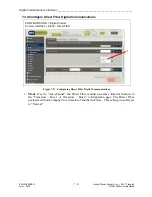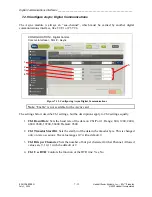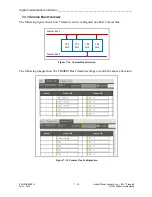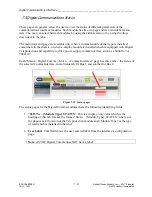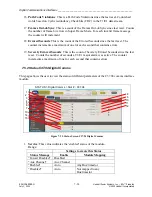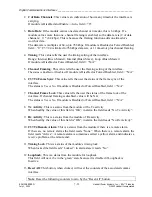
Digital Communications Interfaces ________________________________________________________
RF-MCGARDPRO
Hubbell Power Systems, Inc.
–
RFL™
Products
July 1, 2022
©2022 Hubbell Incorporated
7-15
7.3.2 Timeslot Configuration Rules
The rules which determine other behaviors of these tabs and the options available in the drop-
downs for both function and interface are defined below.
Note
: The rules will be more comprehensible after going through this whole section.
Bus Master and Bus Timing
•
If only one interface is programmed on a Bus, then that interface is the “Bus Master”. Its
“Timing” is set to “Internal” or “Loop”, selected by the user. Default is Internal.
•
If more than one interface is programmed on a Bus, the Bus Master may be selected in
the drop-down menu.
DEFAULT: The module which occupies the lowest # timeslot is the default Bus Master.
For example, if you select G.703 on TS2 and then select C37.94 on TS1, C37.94 is the
Master.
•
If an interface is programmed on a Bus (occupying at least one timeslot on the Bus), but
is not the Bus Master, it is programmed as a “Slave”. When this is the case, its timing is
forced to INTERNAL.
Framing
•
For RS-449/X.21/V.35, C37.94, and Long-Haul Fiber: Framing is ENABLED on an
interface if more than one timeslot is used on that interface.
•
The 64kbps framing data is only added to the interface not the bus. Interfaces can still
use all 12 timeslots of a bus for a total of 13x64kbps data rate. The C37.94 interface is
limited to 12x64kbps according to the standard and therefore can only utilize 11
timeslots plus framing.
•
If a Service Channel is enabled over an interface, that interface has framing ENABLED
automatically, regardless of how many timeslots it occupies.
T1/E1 Specifics
•
A T1/E1 module occupies ALL timeslots on the bus. If a T1/E1 module is selected for
any timeslot, all other timeslots are assigned to the T1/E1 module. Also, any unused
“function” timeslots are automatically set to “Idle”.
•
If another module is already occupying a timeslot on a Bus, and a T1/E1 module is
selected as the interface on another timeslot, it will “kick out” the other module, and all
timeslots will be populated with T1/E1.
•
If a T1/E1 module is already occupying a Bus, and another module like C37.94 is
selected as the interface on a timeslot on that Bus, it will replace the T1/E1 module from
all other timeslots on that Bus.
•
If the T1/E1 is selected as the bus interface, and there are two T1/E1 modules installed
in the chassis, and both are programmed as “Drop-and-Insert”, then the option in the
Function drop-down called “Not Used” is re-named “Pass-Thru”. Pass-thru timeslots
will not terminate locally and will traverse between the two buses/interfaces.











